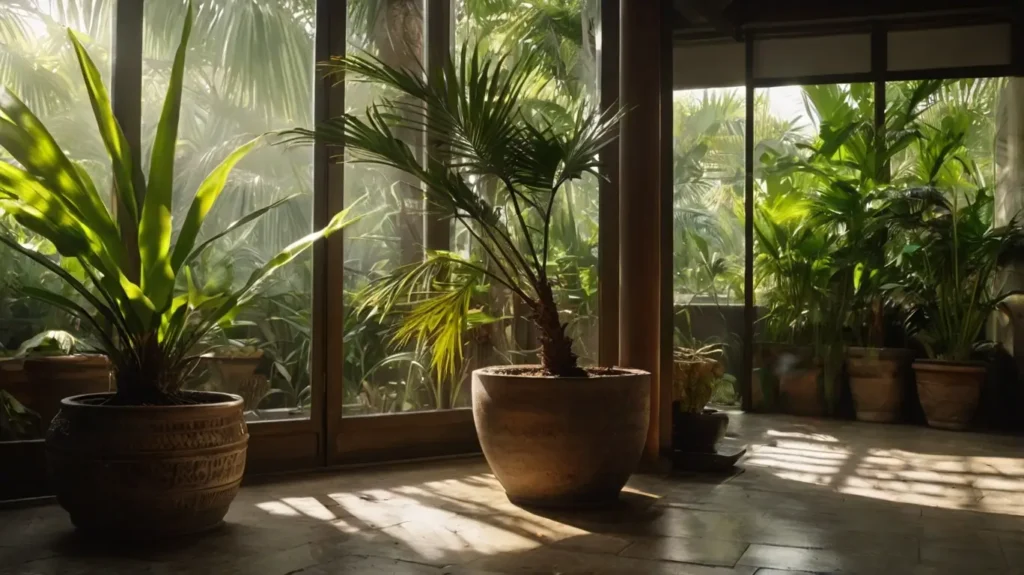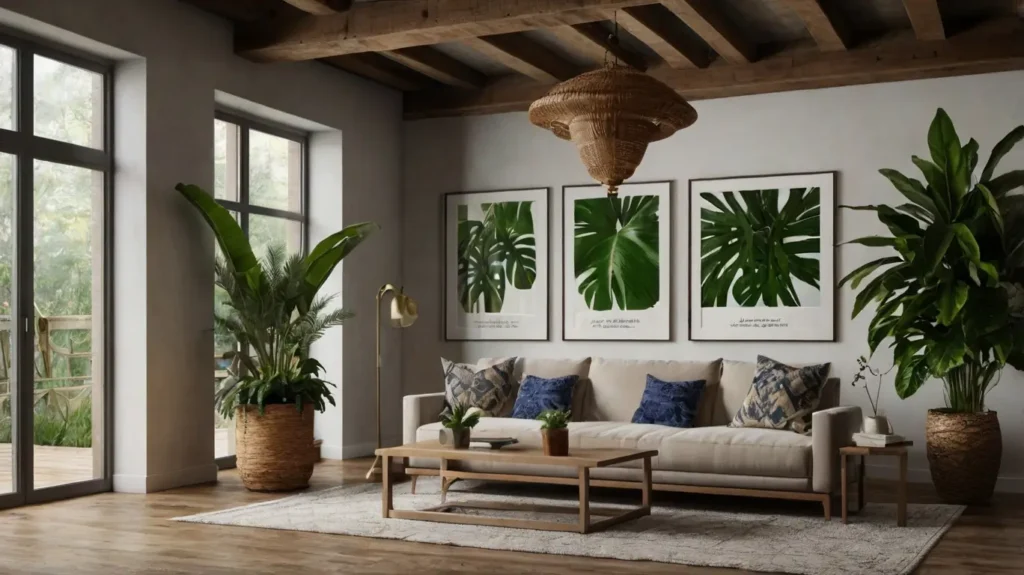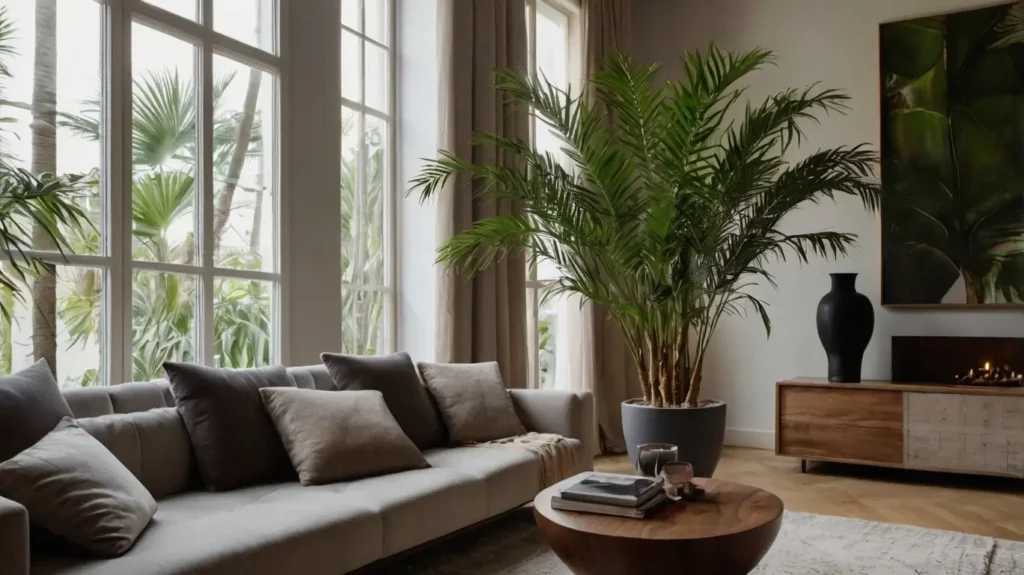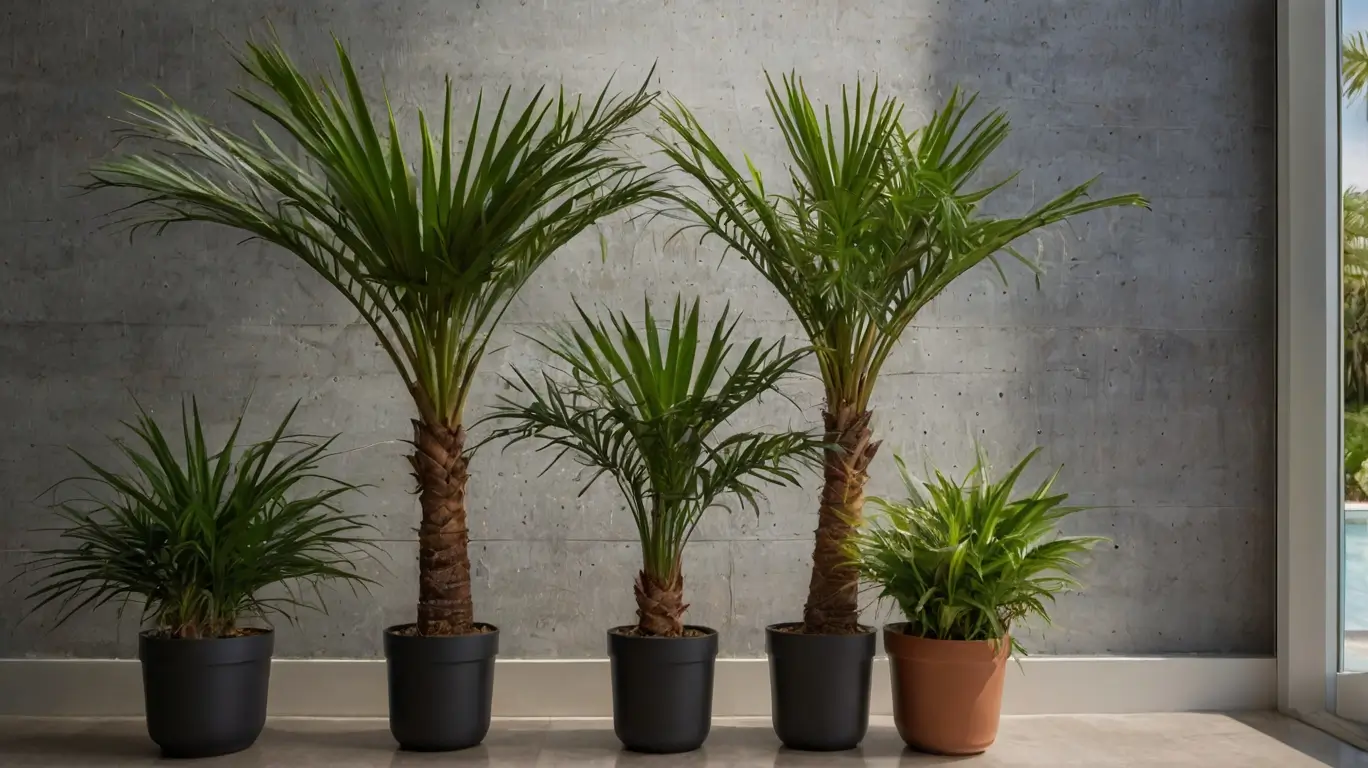What Is the Smallest Type of Palm Tree? Unbelievably Beautiful!
Have you ever caught yourself admiring a palm tree, drawn in by its graceful fronds swaying in the breeze? Whether you’ve encountered them in a tropical paradise or brought them into your living space as houseplants, palm trees never fail to captivate with their beauty.
But what if I told you that size doesn’t always equate to grandeur when it comes to palms? In fact, the smallest types of palm trees can often hold just as much charm—if not more—than their towering counterparts.
So, what is the smallest type of palm tree? You might be surprised to learn that many of these diminutive wonders are not only manageable in size but also extraordinarily beautiful.
Whether you’re thinking of sprucing up your home with a palm or creating a lush garden in a limited space, small palms might just be the perfect choice.
In this article, we’ll take a closer look at the smallest types of palm trees, exploring their beauty, care tips, and ideal growing conditions.
If you’ve been wondering about these lesser-known gems, keep reading—you might just discover a new favorite plant to add to your collection.
Why Size Matters When It Comes to Palm Trees

When you think of palm trees, you might picture towering giants with broad leaves swaying in the wind. But when it comes to selecting the perfect palm tree for your space, size is an important consideration.
In fact, small palms can offer a range of benefits that larger varieties might not. So, what is the smallest type of palm tree, and why does size matter so much?
Smaller Palms Fit Well in Compact Spaces
Smaller palm trees are ideal for tight spaces—whether you’re working with a small apartment, a cozy balcony, or even a modest garden. Large palms, with their broad trunks and sprawling fronds, can quickly become overwhelming in limited spaces.
On the other hand, small palm trees like the Chamaedorea or Pygmy Date Palm (Phoenix roebelenii) thrive in confined areas, making them perfect candidates for compact locations.
Whether placed in a decorative pot or nestled into a corner of your garden, these small beauties can bring a tropical flair to your home without taking over your entire space.
If you’ve ever wondered what is the smallest type of palm tree that would fit on your windowsill, the answer may be closer than you think!
The Beauty of Subtle Details
One of the most fascinating aspects of smaller palm trees is their beauty, which often lies in the details.
While large palms are undeniably dramatic with their towering trunks and massive fronds, small palms have a quiet elegance that can be equally enchanting.
The delicate leaves, soft fronds, and intricate patterns of small palms provide a unique aesthetic that larger palms can’t match.
Take the Rhapis excelsa (Dwarf Palm), for example. Its compact size doesn’t take away from its grandeur; rather, its fan-shaped fronds and bushy appearance bring a sense of lush greenery to any environment.
The appeal of small palms lies in their subtle beauty—the kind of charm that can turn any space into an inviting oasis.
So, what is the smallest type of palm tree that showcases this type of detailed beauty? Consider the Parlor Palm (Chamaedorea elegans).
It’s known for its ability to create a sophisticated yet understated presence in a room, with its slender stems and gracefully arching leaves.
Aesthetic Value for Indoor and Outdoor Settings
Size matters not only for practical reasons but for aesthetic ones as well. Small palm trees are incredibly versatile and can easily transition between indoor and outdoor spaces.
If you’re looking to add a touch of greenery to your living room, the smallest type of palm tree might be your best bet. These palms can fit into various decor styles, from modern to traditional, without overwhelming the room’s design.
Outdoors, small palms can brighten up your garden, porch, or balcony with minimal maintenance. In fact, their adaptability to different environments—whether in full sun or partial shade—makes them ideal for various settings.
If you’re asking what is the smallest type of palm tree for an outdoor container garden, many small palms can thrive in pots and planters, allowing for easy mobility and flexibility in design.
Growth Rate and Adaptability of Small Palms
The growth rate of small palm trees varies, but in general, these palms tend to grow slower than their larger counterparts, which can work to your advantage.
Slower-growing palms like the Pygmy Date Palm (Phoenix roebelenii) won’t require frequent re-potting or constant trimming, making them a low-maintenance option for indoor spaces.
Plus, their moderate growth means they won’t outgrow their space quickly, so you can enjoy their beauty for years without worrying about them becoming too large.
Additionally, smaller palms are often more adaptable to different climates and conditions. Whether you’re growing them indoors in cooler environments or outdoors in warmer regions, small palms are known for their ability to thrive in a range of settings.
If you’re still wondering what is the smallest type of palm tree that suits your specific climate, rest assured that there’s likely a variety that can fit your needs.
What Is the Smallest Type of Palm Tree?
If you’ve ever asked yourself what is the smallest type of palm tree, you’re in for a treat. These palm trees might be small in stature, but they’re big on charm and adaptability.
While palm trees are often associated with towering, majestic varieties, the smallest types of palm trees offer just as much beauty, with the added bonus of being easy to fit into smaller spaces.
So, let’s take a closer look at the smallest palms, each of which can bring a unique tropical touch to your home or garden.
1. Chamaedorea (Parlor Palm)
One of the most beloved small palm trees, the Chamaedorea, often goes by the name “Parlor Palm” due to its popularity as an indoor plant.
What is the smallest type of palm tree for those with limited space indoors? The Chamaedorea is a standout. It grows to an average height of just 3 to 4 feet, making it ideal for apartments, living rooms, or offices.
With its slender stems and elegant fronds, this palm can add a touch of sophistication to any space.
Key Characteristics:
- Appearance: The Chamaedorea has soft, feathery leaves that create a lush, tropical look without being overpowering.
- Growth Habits: This palm is slow-growing, which makes it a low-maintenance plant. It thrives in indirect light and can tolerate lower light conditions, making it a favorite for indoor environments.
- Ideal Growing Conditions: Chamaedorea palms prefer a temperature range of 60–75°F and need well-drained, slightly acidic soil. While it can tolerate dry air, it appreciates humidity, so it’s perfect for bathrooms or kitchens with proper care.
Supporting Data:
- Height: 3–4 feet.
- Growth Rate: Slow, averaging 3–5 inches per year.
- Light Requirements: Low to moderate indirect light.
2. Pygmy Date Palm (Phoenix roebelenii)
If you’re wondering what is the smallest type of palm tree that combines both beauty and a bit of drama, the Pygmy Date Palm (Phoenix roebelenii) might be your answer.
This palm grows to a height of about 6–8 feet, which, although taller than the Chamaedorea, still qualifies as a small palm compared to many other varieties.
Its slender trunk and feathery, arching fronds create an elegant, yet striking, appearance.
Key Characteristics:
- Appearance: The Pygmy Date Palm features dense, dark green fronds that arch gracefully, offering a tropical aesthetic without becoming too imposing. Its slender trunk adds a modern, minimalistic vibe to spaces.
- Growth Habits: While it’s a slow grower, the Pygmy Date Palm can eventually reach up to 8 feet tall. This palm tree is incredibly adaptable and can be grown indoors or outdoors, provided it’s shielded from extreme cold.
- Ideal Growing Conditions: It thrives in full sun or partial shade and prefers well-draining, sandy soil. The Pygmy Date Palm requires moderate watering and is quite drought-tolerant once established. It’s ideal for areas with temperatures between 50–80°F.
Supporting Data:
- Height: 6–8 feet.
- Growth Rate: Slow, with increases of 4–6 inches per year.
- Light Requirements: Full sun to partial shade.
3. Dwarf Palms (Rhapis excelsa)
Among the smallest palms, the Dwarf Palm, or Rhapis excelsa, holds a special place due to its lush, bushy foliage and compact size.
Often referred to as the “Lady Palm,” it typically maxes out at 3–5 feet in height, making it perfect for homes or offices with limited space.
Key Characteristics:
- Appearance: The Rhapis excelsa has broad, fan-shaped leaves that grow in dense clusters, giving it a bushy appearance. Its multi-stemmed growth habit creates an elegant, full look.
- Growth Habits: This palm grows slowly, and although it can eventually spread out, it tends to remain a manageable size. It’s well-suited for indoor environments, especially if you’re looking for a palm that doesn’t need constant pruning.
- Ideal Growing Conditions: It thrives in moderate to bright indirect light and prefers slightly acidic, well-drained soil. Unlike some other small palms, it enjoys higher humidity levels, making it a great option for bathrooms or kitchens. Rhapis excelsa can also tolerate a variety of temperature conditions, typically between 60–75°F.
Supporting Data:
- Height: 3–5 feet.
- Growth Rate: Slow, with increments of about 2–4 inches annually.
- Light Requirements: Bright, indirect light.
4. Other Notable Small Palms
While the Chamaedorea, Pygmy Date Palm, and Dwarf Palm are among the most popular smallest types of palm trees, there are other varieties worth mentioning for their compact size and beauty.
- Needle Palm (Rhapidophyllum hystrix): This palm is one of the hardiest small palms, capable of surviving in colder climates. It typically grows to about 3–5 feet and has spiny, needle-like fronds that give it a unique appearance.
- Coco Palm (Cocos nucifera – Dwarf Varieties): Smaller cultivars of the Coconut Palm, particularly the Dwarf Coconut Palm, grow to around 4–6 feet, making them perfect for smaller yards or containers.
- Bismarck Palm (Bismarckia nobilis – Dwarf Varieties): Though typically known for its large size, the dwarf variety of the Bismarck Palm stays compact, with a maximum height of about 6 feet, offering a stunning look without overwhelming your space.
What is the smallest type of palm tree for your space? Whether you’re looking to brighten up your apartment, garden, or office, these small palm varieties offer versatility and beauty without taking over.
Each has its own distinct characteristics, making it easier for you to find the perfect palm to suit your needs and style.
The Beauty of Small Palm Trees: What Makes Them So Appealing?

When you think of palm trees, you may envision towering giants that dominate landscapes. But the smallest types of palm trees have their own special charm.
Despite their size, small palms can be just as captivating as their larger counterparts, often possessing delicate beauty and a unique elegance that can’t be overlooked.
Delicate and Elegant Foliage
One of the primary reasons small palm trees are so appealing is their intricate, finely detailed foliage. The fronds of smaller palms like the Chamaedorea or Rhapis excelsa are delicate, with soft edges and graceful arches.
Their fine leaves add a lush, tropical aesthetic to any space, making them perfect for adding a refined yet nature-filled vibe, whether in a home or garden. Their smaller scale makes them ideal for close inspection, allowing you to appreciate their subtle, yet stunning beauty up close.
Ability to Thrive in Diverse Environments
Another key factor behind the appeal of the smallest types of palm trees is their adaptability. These palms are versatile and can thrive in a range of environments, whether indoors or outdoors.
Many small palms, like the Pygmy Date Palm (Phoenix roebelenii), can handle full sun or partial shade, making them suitable for various climate conditions.
Indoors, they require little more than indirect light and occasional watering, making them a great option for spaces that don’t receive direct sunlight.
Whether you’re cultivating a palm for your living room, balcony, or small garden, what is the smallest type of palm tree that can adapt to your environment might just be one of these beauties.
Their adaptability makes them ideal for plant lovers of all skill levels.
Low Maintenance Yet Visually Impressive
The smallest types of palm trees are often surprisingly low maintenance, making them a go-to choice for busy individuals. Small palms don’t require constant attention, and many are drought-tolerant once established.
Their manageable size makes them perfect for beginners or those who don’t have the time to tend to larger, high-maintenance plants. Yet despite their low upkeep, these palms are visually striking, offering a sophisticated look with minimal effort.
The combination of elegance, easy care, and a compact footprint makes these small palms perfect for anyone seeking a gorgeous, hassle-free plant.
Supporting Information:
For design inspiration, small palms can be used in various home or garden settings. For instance, a Chamaedorea palm placed in a decorative pot can brighten up a modern living room, while the Pygmy Date Palm, when potted and placed on a patio, adds an exotic touch to any outdoor setting.
Grouping small palms with other plants in a stylish arrangement can elevate the aesthetic appeal of your space.
Where Can You Grow the Smallest Palm Trees?
Wondering what is the smallest type of palm tree and where it can grow? These versatile palms can thrive in both indoor and outdoor spaces, as long as they’re provided with the right conditions. Let’s explore the best places for growing these charming palms.
Indoor vs. Outdoor Growth
Small palm trees are some of the most adaptable plants around. Many varieties can be grown both indoors and outdoors, but the conditions they require may differ slightly depending on their environment.
- Indoor Growth: Indoors, smaller palms thrive in bright, indirect light and moderate temperatures. They make wonderful houseplants because they can fit into tight spaces and require little maintenance. For example, what is the smallest type of palm tree for an indoor setting? The Chamaedorea palm is perfect for this environment.
- Outdoor Growth: Outdoors, small palms are well-suited for tropical and subtropical climates where they receive plenty of sunlight. They are ideal for growing in coastal areas, tropical gardens, and other warm regions. However, most small palms, like the Pygmy Date Palm, should be protected from frost.
Climate Preferences: Tropical and Subtropical Conditions

Small palms generally thrive in tropical and subtropical climates, where temperatures range between 60°F and 85°F.
They prefer humidity and well-draining soil. Understanding what is the smallest type of palm tree that can grow in your area is key to ensuring your palm flourishes. If you’re in a cooler climate, consider growing small palms in containers so they can be moved indoors during the colder months.
Container Gardening Options
One of the best ways to grow small palms, especially for those with limited garden space, is container gardening.
Small palms like the Dwarf Palm (Rhapis excelsa) or Pygmy Date Palm do well in pots, allowing you to easily move them around or even take them indoors during the winter.
Care Tips for Small Palm Trees: Keeping Them Healthy and Beautiful
Now that you know what is the smallest type of palm tree, let’s dive into how to keep them healthy and beautiful. Small palm trees are relatively easy to care for, but there are a few essential tips to keep in mind.
Proper Watering Techniques
Watering is crucial for maintaining the health of your small palm trees. However, over-watering is a common mistake.
For most small palms, it’s best to water deeply but allow the soil to dry out between waterings. The Pygmy Date Palm, for example, prefers dry soil between waterings, while the Chamaedorea can tolerate slightly more moisture.
Ideal Soil and Potting Requirements
Well-draining soil is essential for small palms. Avoid heavy, clay-based soils that can hold too much water.
Opt for a light, loamy mix that will allow excess water to drain away. If you’re growing your palm in a container, ensure the pot has drainage holes to prevent root rot.
Temperature and Humidity Considerations
The smallest types of palm trees generally prefer warm temperatures and humidity. If you’re growing them indoors, placing them in areas with moderate to high humidity (like kitchens or bathrooms) can help them thrive. Alternatively, use a humidity tray or room humidifier to boost moisture in the air.
Common Pests and Diseases
While small palms are relatively low-maintenance, they can still fall victim to pests like spider mites, scale, or mealybugs.
Regularly inspect your palms for pests and treat them with insecticidal soap if needed. Root rot can also be an issue if the palm is overwatered, so be mindful of your watering schedule.
Watering Tips:
- Water deeply but allow the soil to dry between waterings.
- Avoid waterlogging, especially in containers.
Fertilization:
- Feed your small palms during the growing season with a balanced fertilizer.
- Apply fertilizer every 4–6 weeks to encourage healthy growth.
Pruning:
- Trim dead or yellowing fronds regularly.
- Prune sparingly to avoid stressing the plant.
Aesthetic Ideas for Small Palm Trees in Your Space
Small palm trees aren’t just easy to care for—they can also elevate the aesthetic appeal of any space. Whether you’re styling your indoor or outdoor area, small palms have the versatility to complement various decor styles.
How Small Palms Complement Different Decor Styles
The clean lines and tropical allure of small palms work well in both modern and traditional settings. In a minimalist room, a small palm such as the Chamaedorea adds a pop of greenery without overpowering the design.
In a more traditional space, grouping small palms with other houseplants or decorative elements creates a lush, welcoming atmosphere.
The Versatility of Small Palms
Small palms work beautifully in pots, hanging baskets, or even as part of a larger plant grouping.
The upright growth of the Pygmy Date Palm or the bushy, multi-stemmed look of the Rhapis excelsa can create focal points in your home or garden.
Table: A Quick Guide to Small Palm Trees
| Palm Type | Best Use (Indoor/Outdoor) | Ideal Size Range | Growth Habit |
|---|---|---|---|
| Chamaedorea (Parlor Palm) | Indoor | 3–4 feet | Compact |
| Pygmy Date Palm | Outdoor, Indoor (pot) | 6–8 feet | Upright |
| Dwarf Palms (Rhapis excelsa) | Indoor | 3–5 feet | Bushy |
FAQ: What You Need to Know About the Smallest Palm Trees
What is the smallest type of palm tree for indoors?
The Chamaedorea, also known as the Parlor Palm, is the smallest and most adaptable palm for indoor settings. It typically grows to a height of 3–4 feet, making it perfect for tight spaces and homes that don’t receive direct sunlight.
It’s a great choice for anyone looking to add a touch of greenery to their indoor environment without taking up too much space.
Can small palms be grown in cold climates?
Most small palm species thrive in warmer, tropical, and subtropical climates. However, some varieties—like the Pygmy Date Palm (Phoenix roebelenii)—can tolerate mild frost, especially if they’re protected and cared for properly.
If you’re in a colder climate, consider growing small palms in containers so you can bring them indoors during colder months.
Are small palms easy to care for?
Yes, small palms are generally very easy to care for! They are low-maintenance and don’t require constant attention.
With just a bit of water, the right amount of light, and occasional pruning, these palms can thrive for years. Just remember not to overwater them and to place them in a spot where they can get indirect light.
Can I grow small palm trees in a container?
Absolutely! Many small palm trees, such as the Chamaedorea and the Dwarf Palm (Rhapis excelsa), thrive in containers.
This makes them ideal for apartment living or patios where space is limited. Growing small palms in containers also allows you to easily move them indoors when the weather turns colder, offering a practical and flexible way to enjoy these beautiful trees year-round.
Conclusion: Embrace the Beauty of Small Palm Trees
Small palm trees may not be the giants you typically associate with tropical landscapes, but they have their own quiet beauty and charm.
Whether you’re asking what is the smallest type of palm tree for your home or garden, these palms prove that good things really do come in small packages. With their delicate fronds, low maintenance needs, and versatility, small palms are a perfect addition to any space.
So, why not consider bringing one of these elegant little trees into your home or garden? They offer a unique way to introduce tropical vibes into your living environment, while their compact size ensures they fit seamlessly into smaller spaces.
Whether you’re looking to brighten up your living room, add greenery to your office, or enhance your outdoor space, a small palm tree can provide the perfect touch of natural beauty.
Add a small palm tree today, and watch as it transforms your space into a serene and sophisticated sanctuary.

